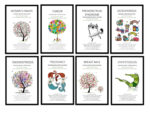Cholesterol
Cholesterol is a vital component of our cells, which is why our body makes all that we need.
For most Americans eating a conventional diet, plaque accumulates inside the coronary arteries that feed our heart muscle. This plaque buildup, known as atherosclerosis, is the hardening of the arteries by pockets of cholesterol-rich fatty material that builds up beneath the inner linings of the blood vessels. This process seems to occur over decades, slowly bulging into the space inside the arteries, narrowing the path for blood to flow.
The restriction of blood circulation to the heart may lead to chest pain and pressure when people try to exert themselves. If the plaque ruptures, a blood clot may form within the artery. This sudden blockage of blood flow may cause a heart attack, damaging or even killing part of the heart.
A large body of evidence shows there were once enormous swaths of the world where the coronary heart disease epidemic seemed to be almost non-existent, such as rural China and sub-Saharan Africa. It’s not genetics: When people move from low- to high-risk areas, their disease rates appear to skyrocket as they adopt the diet and lifestyle habits of their new homes. The extraordinarily low rates of heart disease in rural China and Africa have been attributed to the extraordinarily low cholesterol levels among these populations. Though Chinese and African diets are very different, they are both centered on plant-derived foods, such as grains and vegetables. By eating so much fiber and so little animal fat, their total cholesterol levels averaged under 150 mg/dL, similar to people eating contemporary strictly plant-based diets.
According to William C. Roberts, editor in chief of the American Journal of Cardiology, the only critical risk factor for atherosclerotic plaque buildup is cholesterol, specifically elevated LDL cholesterol in our blood. To drastically reduce LDL cholesterol levels, it appears we need to drastically reduce our intake of trans fat, which comes from processed foods and naturally from meat and dairy; saturated fat, found mainly in animal products and junk foods; and, playing a lesser role, dietary cholesterol, found exclusively in animal-derived foods, especially eggs.
Notice the pattern? The three boosters of bad cholesterol—a leading risk factor for our number-one killer—all stem from eating processed foods and animal products. This likely explains why populations living on traditional diets revolving around whole plant foods have largely remained free from the epidemic of heart disease.
- Menopausal Hot Flashes Are Not Inevitable
- Soy Milk for Vaginal Menopause Symptoms
- Hormone Treatment (Estrogen Pills and Creams) for Vaginal Menopause Symptoms
- The Best Moisturizers and Lubricants for Vaginal Menopause Symptoms
- Oxidized Cholesterol 27HC May Explain 3 Breast Cancer Mysteries
- What About Kosher and Organic Chicken?

